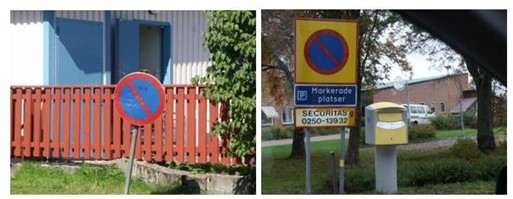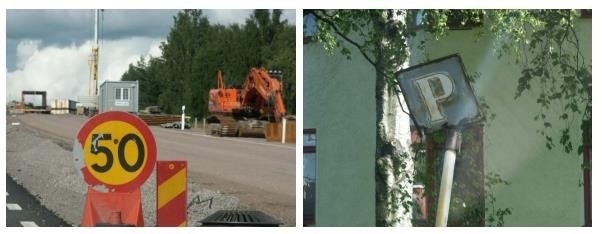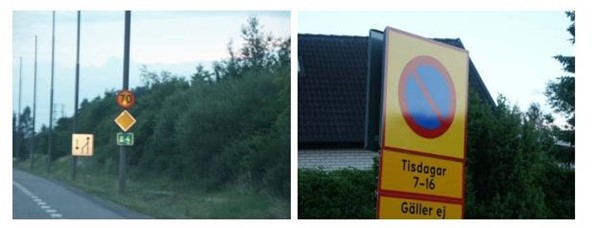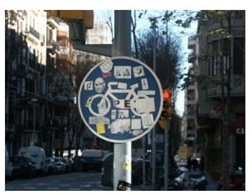Literature Review Sample Work
Potential Difficulties in Traffic Sign Recognition
Info: 2048 words Sample Literature Review
Published: 20th DEC 2022
Tagged: Medical & Healthcare
Traffic signs can be found in a variety of states, such as old, deteriorated, misdirected, etc., and as a result, all or most of the following factors may make it difficult to detect and recognise these signs. The sign's color will gradually deteriorate as a result of extended exposure to the sun and paint that has come into contact with air (Ma et al., 2020). It could be more difficult to see when one or more atmospheric factors like mist, rain, clouds, or snow are present. Changes in the local light, such as those in the light's direction, intensity, season, and time of day, can have an impact on visibility. The shadows that the nearby items cast also need to be considered (Gupta et al., 2021).
The complexities of lighting, such as shadow, cloud cover, and sunlight, have a profound impact on color information. The lighting geometries, viewing geometry, and color of the light source are only a few variables that could have an impact (daylight). There are many obstructions in the area, including those that block other symbols, including those, such as trees, buildings, cars, people, and even other signs. the existence of objects in the evaluation area, such as buildings or cars, which are comparable in color or design to the traffic signs (Ahsan et al., 2019). They may resemble a traffic sign in terms of form, color, or even both. In the first illustration in Figure 1, a fence is depicted that matches the hue of a road sign. The second example displays two distinct examples. In the second instance, a post box that matches the traffic signals' size, shape, and color is positioned next to them.

Figure 1. Similar objects in the scene or similar background color
Some signs may become obscured, damaged, or confused when there are multiple impediments present, such as other signs. Figure 2's symbols stand for two unique damaged signals. The dark crimson rim on the one on the left is damaged, as contrasted to the one on the right, which is fairly ancient, corroded, and destroyed (Kiruthika et al., 2021). The color faded with time along with it. Depending on the distance between the camera and the sign, the sign's size will alter. It's possible that the image orientation makes street signs appear to be rotated.

Figure 2. Damaged signs.
Figure 3 displays two views of the same sign taken back-to-back and from two different locations on the freeway. Motion blur and automobile sway are typically seen in the produced image. Motion blurring could be expected over a certain level because the recognition algorithm cannot account for the car's movements (Khan & Lee, 2019). If an object moves continually and unmodified, it can be used to anticipate its future movements.

Figure 3. Size of signs depends on the distance between the camera and the sign
Two distorted images are displayed in Figure 4. It is obvious that movement has blurred the image on the left. The sign is visible in the illustration to the right, but it is also clear that motion has occurred in the background. Figure 5 shows that during the brief daytime hours, traffic signs frequently reflect sunlight from the sky or from an approaching vehicle or produce highlights. Even though the sign on the right appears to be reflecting light from the sky onto the camera in the image on the right, the car's headlights are clearly visible on the sign board in the image on the left (Barodi et al., 2021). This frequently occurs when taking images at dawn or at night. Many different colors and pictograms are used by many nations.

Figure 4. Motion blur problem

Figure 5. Reflection from sign board.
In Figure 6, the YIELD sign is shown in two different ways. The photos on the left and right, which are of the Netherlands and Sweden respectively, were both taken there. The interior of the warning sign is generally recognised in Sweden as being yellow, notwithstanding the possibility that the 2 sign rim colors may differ. Figure 7 shows the identical pedestrian crossing sign for Poland, the Netherlands, Austria, and Sweden, which are four different European countries. The four images are compared and it can be seen that each nation utilises its own collection of pictograms (Tong et al., 2020). People damage signs by sticking stickers on them, writing on them, or reshaping the pictograms.

Figure 6. Colors in different countries: left, Netherlands; right, Sweden.

Figure 7. Different pictograms are used in different countries.
Figure 8 shows an instance typical of Barcelona, Spain. The sign has an extremely high number of stickers on it. lack of a unified database to evaluate current categorization techniques (Wang, 2018). From the aforementioned potential issues, it can be concluded that methods for the recognition and detection of traffic as well as the color classification of traffic signs must be extremely robust, reduced lack of responsiveness to noise and irradiance variants, and therefore should be irreversible to dimensional shapes effects like signal transduction, in-plane and out-ofplane rotations, and scalability changes in the image (Cao et al., 2019).

Figure 8. Stickers which damaged the pictogram of a sign.
Images from actual events were used to define and describe potential concerns as well as to highlight the challenges that can arise when using traffic signs. The concept of traffic sign recognition was also covered in this chapter, along with its definition, significance, and applications. It is shown that the two crucial procedures of classification and tracking serve as the mechanisms of sign identification (Yang et al., 2018). The visual attributes of the sign would be used to identify it before its shape. In order to determine the category of the sign based on the pictogram, features are then extracted from the detection process and applied to a particular classifier (Wali et al., 2019). Related work
Road and Traffic Sign Detection and Recognition
Authors (Haque et al., 2021) proposed DeepThin architecture divided into three modules input processing, learning, and prediction. Image resizing is done in preprocessing.
Four convolutional layers, two overlapping max-pooling layers followed by a single fully connected hidden layer were used for learning, and class prediction is done with the help of CNN. However only the color characteristic of the sign is considered during the detection process. They concentrated on the RGB and grayscale values of signs.
Researchers (Vennelakanti et al., 2019) proposed that Hue Saturation Value (HSV) color space is used instead of RGB for color-based detection. The Douglas Peucker algorithm is then used for shape-based detection. But the limitation is that good accuracy is achieved but only triangular and circular shapes are considered for detection.
Yuan et al. (2019) presented a complete traffic sign detection approach. It is possible to extract effective features for different image sizes using the multi-feature fusion network structure. Various approaches have enhanced the accuracy of traffic sign identification, but there are still benefits and drawbacks between the algorithms, which a variety of circumstances will restrict.
The authors (Matos et al., 2019) have implemented using SVM for classification and HOG descriptor for feature extraction. The SVM classifier is often used to train and test the model. However, only triangular and circular shapes are considered for detection.
The authors Matos et al.(2019) proposed "The Speed Limit Road Signs Recognition Using Hough Transformation and Multi-Class SVM". Hue, saturation, and lightness (HSL) values are employed in this paper's preprocessing phase to boost the contrast in dataset photos, making detection easier. Despite the fact that the system performs admirably for its original intention, there are several weaknesses in the detection method that might be addressed by employing some of the more recent techniques that improve detection accuracy.
Authors (Song et al., 2019) focused on issues of small object detection and compared accuracy against R-CNN and Faster R-CNN.CNN Model is optimized using convolution factorization, redundant layer cropping and fully connected transformation. Image preprocessing details are missing
A comparative study of different benchmarks have been performed by Qin and Yan (2021) to determine the most suitable deep learning models for traffic sign recognition. From the study, it is seen that Fast R-CNN and YOLOv5 work efficiently for traffic sign recognition.
Researchers (Tabernik & Skocaj, 2020) used the mask R-CNN for traffic sign detection and recognition. To have low inter-class and high intra-class variability, they produced new data set called DFG traffic-sign. But the drawback is that the authors failed to consider the miss detection of traffic signs scenarios
Research Gap
To guarantee a safe road communication, traffic signs are essential for driver awareness. Hundreds of people die, and thousands more are seriously hurt every year due to traffic accidents, despite well-designed traffic signals being in place. In circumstances where drivers have misread traffic signs owing to exhaustion or lack of concentration, an AI-based traffic sign detection system can help (Tabernik & Skocaj, 2020). From the various studies on traffic sign recognition, it is seen that deep learning is the most suitable and effective. There is still some drawback in the existing studies where the accuracy is comparatively low, and there is lots of scope for improvement. Hence, deep learning algorithms will be used in this study for the implementation.
References
Ahsan, S.M.M., Das, S., Kumar, S. & La Tasriba, Z. 2019. A Detailed Study on Bangladeshi Road Sign Detection and Recognition. In: 2019 4th International Conference on Electrical Information and Communication Technology (EICT). December 2019, IEEE, pp. 1–6.
Barodi, A., Bajit, A., Benbrahim, M. & Tamtaoui, A. 2021. Improving the transfer learning performances in the classification of the automotive traffic roads signs S. Bourekkadi, J. Abouchabaka, O. Omari, & K. Slimani (eds.). E3S Web of Conferences. (234). pp. 00064.
Cao, J., Song, C., Peng, S., Xiao, F. & Song, S. 2019. Improved Traffic Sign Detection and Recognition Algorithm for Intelligent Vehicles. Sensors. (19)18,. pp. 4021.
Gupta, A., Anpalagan, A., Guan, L. & Khwaja, A.S. 2021. Deep learning for object detection and scene perception in self-driving cars: Survey, challenges, and open issues. Array. (10). pp. 100057
Haque, W.A., Arefin, S., Shihavuddin, A.S.M. & Hasan, M.A. 2021. DeepThin: A novel lightweight CNN architecture for traffic sign recognition without GPU requirements. Expert Systems with Applications. (168). pp. 114481.
Khan, M.Q. & Lee, S. 2019. A Comprehensive Survey of Driving Monitoring and Assistance Systems. Sensors. (19)11,. pp. 2574
Kiruthika, S., Aashin, A., Gopinath, K. & Gowtham, A. 2021. Securing Connected & Autonomous Vehicles: Challenges posed by Adversarial Machine Learning and the way forward. Journal of Physics: Conference Series. (1916)1,. pp. 012110
Ma, Y., Wang, Z., Yang, H. & Yang, L. 2020. Artificial intelligence applications in the development of autonomous vehicles: a survey. IEEE/CAA Journal of Automatica Sinica. (7)2,. pp. 315–329
Matos, I., Krpic, Z. & Romic, K. 2019. The Speed Limit Road Signs Recognition Using Hough Transformation and Multi-Class Svm. In: 2019 International Conference on Systems, Signals and Image Processing (IWSSIP). June 2019, IEEE, pp. 89–94.
Qin, Z. & Yan, W.Q. 2021. Traffic-Sign Recognition Using Deep Learning. In: pp. 13–25.
Song, S., Que, Z., Hou, J., Du, S. & Song, Y. 2019. An efficient convolutional neural network for small traffic sign detection. Journal of Systems Architecture. (97). pp. 269–277.
Tabernik, D. & Skocaj, D. 2020. Deep Learning for Large-Scale Traffic-Sign Detection and Recognition. IEEE Transactions on Intelligent Transportation Systems. (21)4,. pp. 1427– 1440.
Tong, K., Wu, Y. & Zhou, F. 2020. Recent advances in small object detection based on deep learning: A review. Image and Vision Computing. (97). pp. 103910.
Vennelakanti, A., Shreya, S., Rajendran, R., Sarkar, D., Muddegowda, D. & Hanagal, P. 2019. Traffic Sign Detection and Recognition using a CNN Ensemble. In: 2019 IEEE International Conference on Consumer Electronics (ICCE). January 2019, IEEE, pp. 1–4.
Wali, S.B., Abdullah, M.A., Hannan, M.A., Hussain, A., Samad, S.A., Ker, P.J. & Mansor, M. Bin 2019. Vision-Based Traffic Sign Detection and Recognition Systems: Current Trends and Challenges. Sensors. (19)9,. pp. 2093.
Wang, C. 2018. Research and Application of Traffic Sign Detection and Recognition Based on Deep Learning. In: 2018 International Conference on Robots & Intelligent System (ICRIS). May 2018, IEEE, pp. 150–152.
Yang, T., Long, X., Sangaiah, A.K., Zheng, Z. & Tong, C. 2018. Deep detection network for real-life traffic sign in vehicular networks. Computer Networks. (136). pp. 95–104.




